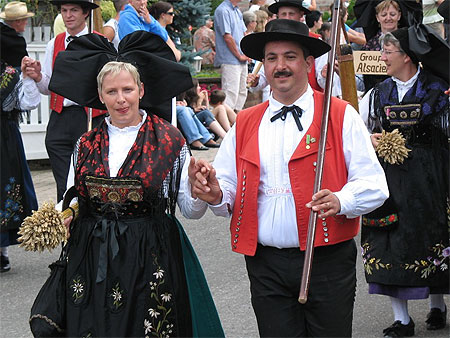Saturday, May 29 – 2pm
It didn’t hit me until I was sitting on the Place de la Republique eating the rest of my day-old baguette. As I checked my map, I read the blurb about the large roundabout where I was enjoying my snack. My eyes began to quickly scan the short paragraph, but I was immediately captured by one sentence that read “the memorial (in the center of the plaza) shows a mother with her two sons, one who died defending France, the other Germany a traumatic experience for many people in Alsace during the two World Wars.”
I guess I didn’t think about where I was going when I nonchalantly hopped on a train in Luxembourg City heading south toward Zurich earlier that morning. I knew the name, Strasbourg, but the historical significance of the city and the region never crossed my mind. As I gazed at the memorial situated at the center of the circular plaza and inscribed with the words “A Nos Morts 1914-1918, 1939-1945, 1945-1952, 1952-1962,” information from AP European History slowly began to resurface.

The region of Alsace has been one of the most disputed territories in Western Europe. Situated along the Rhine River and on the border between France and Germany, the instituted region, now part of France, has been under the control of both countries. Conflict began soon after the region was given to France with the signing of the Treaty of Westphalia in 1648. During the two World Wars, in particular, Alsace the center of intense fighting. As I continued to walk around the memorial, and snap a few quick pictures, it was incredible to think about how such a tiny and seemingly insignificant piece of territory could be a source of so much conflict between neighboring countries. (http://www.visit-alsace.com/librairie/index.html)
The history of the region, but more specifically the periods of control by both France and Germany, has had remarkable influences on the culture of the city and region today. This was clearly evident as I strolled from La Place de Republiqe through the rest of the city. Hungry from a long day of walking, I stopped for a quick bite at a small café off of the La Place Borgire and immediately noticed the German influence. Scrawled on a small and worn-out chalkboard were the daily specials. The one that caught my attention was the spatzle – a traditionally German dish that was listed alongside more common French cuisine. Not only has the food obviously had Germanic influence, but the language and culture have as well. Most notably, members of the Alsatian community speak not only French but also Alsatian, a German dialect that has been highly influenced by French. In addition to language and food, the area has it’s own traditional costumes that are worn on special occasions. It is incredible that two biggest rivals in Europe have had such enormous impacts on the identity and culture of this tiny region. (http://www.tourisme-alsace.com/en/alsace-regional-identity.html)

As I savored my food at the cafe, I thought about the “must-sees” of Strasbourg and I found it interesting that the highlight of my day, and the city’s main attraction, the cathedral, was built prior to there even being a France or a Germany. The Strasbourg Cathedral de Notre-Dame is one of the most famous churches in France. Known for its intricate, lace-like façade, the church was known as the tallest building in the Christian world until the 19th century. As I walked through the church earlier in the afternoon I was in complete awe; the size of the structure was absolutely unbelievable and indescribable. Some of the most beautiful elements that I noted were the soaring pointed arches, the large stained-glass windows, and the interior columns that were all clear evidence to show that the Catholic church could be dated to the gothic period (in particular the 12th century). (http://www.strasbourg.info/cathedral/)
of my day, and the city’s main attraction, the cathedral, was built prior to there even being a France or a Germany. The Strasbourg Cathedral de Notre-Dame is one of the most famous churches in France. Known for its intricate, lace-like façade, the church was known as the tallest building in the Christian world until the 19th century. As I walked through the church earlier in the afternoon I was in complete awe; the size of the structure was absolutely unbelievable and indescribable. Some of the most beautiful elements that I noted were the soaring pointed arches, the large stained-glass windows, and the interior columns that were all clear evidence to show that the Catholic church could be dated to the gothic period (in particular the 12th century). (http://www.strasbourg.info/cathedral/)
After snapping out of my remeniscing of the day, paying my tab, and stopping for an ice cream cone, I decided it was time to make my way towards The Palace of Justice, but more importantly, the Ciarus hostel. Back in my surprisingly clean room, I began to process my day in the city known for being at the crossroads of Europe. Thinking back on all I had seen, I realized how much history was encapsulated in one small town. From a 12th century gothic cathedral, to the reminders of the world wars, to the modern glass building of the European Parliament, it was clear to me that Strasbourg is a city that has been shaped by the past, and is sure to have a promising future.
Really great story! Your account of Strasbourg makes me definitely want to consider visiting all of these great sites. While talking about your adventurous day, I really liked how the history of these places were incorporated. We had learned about the rivers, the Treaty of Westphalia, the World Wars, and the concept of territory. All within one scene while recalling all of the history that is associated. Finally, by applying some of our architecture knowledge, we (as students) could relate to this topic. I really enjoyed reading about your Strasbourg experience!
ReplyDelete